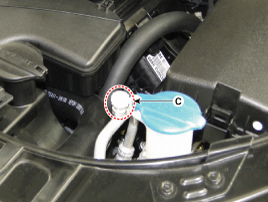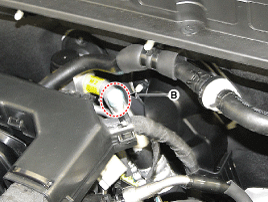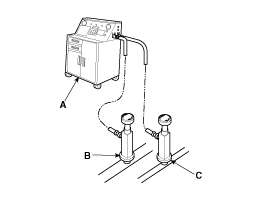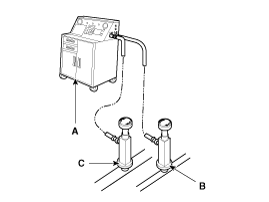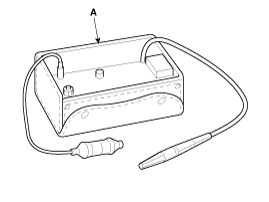 Hyundai Equus: Repair procedures
Hyundai Equus: Repair procedures
| Refrigerant System Service Basics |
Refrigerant Recovery
Use only service equipment that is U.L-listed and is
certified to meet the requirements of SAE J2210 to remove
HFC-134a(R-134a) from the air conditioning system.
|
If accidental system discharge occurs, ventilate the work area before resume of service.
Additional health and safety information may be obtained from the refrigerant and lubricant manufacturers.
| 1. |
Connect a R-134a refrigerant
Recovery/Recycling/Charging system (A) to the high-pressure
service port (C) and the low-pressure service port (B) as shown,
following the equipment manufacturer's instructions.
|
| 2. |
Measure the amount of refrigerant oil removed from the A/C
system after the recovery process is completed. Be sure to install the
same amount of new refrigerant oil back into the A/C system before
charging. |
System Evacuation
Use only service equipment that is U.L-listed and is
certified to meet the requirements of SAE J2210 to remove
HFC-134a(R-134a) from the air conditioning system.
|
If accidental system discharge occurs, ventilate the work area before resume of service.
Additional health and safety information may be obtained from the refrigerant and lubricant manufacturers.
| 1. |
When an A/C system has been opened to the atmosphere, such as
during installation or repair, it must be evacuated using a R-134a
refrigerant Recovery/Recycling/Charging system. (If the system has been
open for several days, the receiver/drier should be replaced, and the
system should be evacuated for several hours.) |
| 2. |
Connect a R-134a refrigerant Recovery/Recycling/Charging
system (A) to the high-pressure service port (C) and the low-pressure
service port (B) as shown, following the equipment manufacturer's
instructions.
|
| 3. |
If the low-pressure does not reach more than 93.3 kPa (700
mmHg, 27.6 in.Hg) in 10 minutes, there is probably a leak in the system.
Partially charge the system, and check for leaks (see Refrigerant Leak
Test.) |
| 4. |
Remove the low pressure valve from the low-pressure service port. |
System Charging
Use only service equipment that is U.L-listed and is
certified to meet the requirements of SAE J2210 to remove HFC-134a
(R-134a) from the air conditioning system.
|
If accidental system discharge occurs, ventilate the work area before resume of service.
Additional health and safety information may be obtained from the refrigerant and lubricant manufacturers.
| 1. |
Connect a R-134a refrigerant
Recovery/Recycling/Charging system (A) to the high-pressure
service port (C) as shown, following the equipment manufacturer's
instructions.
|
| 2. |
Add the same amount of new refrigerant oil to the system that
was removed during recovery. Use only specified refrigerant oil. Charge
the system with R-134a refrigerant [700±25g (24.7±0.88oz.)]. Do not
overcharge the system the compressor will be damaged. |
Refrigerant Leak Test
Always conduct a leak test with an electronic leak detector
whenever leakage or refrigerant is suspected and when conducting service
operations which are accompanied by disassembly or loosening or
connection fittings.
In order to use the leak detector properly, read the manual supplied by the manufacturer. |
If a gas leak is detected, proceed as follows:
| 1. |
Check the torque on the connection fittings and, if too
loose, tighten to the proper torque. Check for gas leakage with a leak
detector (A). |
| 2. |
If leakage continues even after the fitting has been
tightened, discharge the refrigerant from the system, disconnect the
fittings, and check their seating faces for damage. Always replace, even
if the damage is slight. |
| 3. |
Check the compressor oil and add oil if required. |
| 4. |
Charge the system and recheck for gas leaks. If no leaks are found, evacuate and charge the system again.
|
 Description and Operation
Description and Operation
Refrigeration Cycle
...
 Components and Components Location
Components and Components Location
Component Location Index
Engine Room
1. Receiver-drier2. Condenser3. Ambient Temperature Sensor4. Compressor5. Discharge Hose6. Suction & Liquid Tube Assembly7. Service Port (Low Pressure)8. ...
See also:
Reservoir Tank Repair procedures
Removal
•
Before replacing the relevant parts, use GDS equipment to fully discharge the air from the relevant parts.
(Refer to Air Suspension System - "Repair procedures ...
Restrictions in Handling Keys
When leaving keys with parking lot and valet attendants, the following procedures
will ensure your vehicle’s trunk and glove box compartment can only be opened with
the mechanical key.
To l ...
Tire specification and pressure label
The tires supplied on your new vehicle are chosen to provide the best performance
for normal driving.
The tire label located on the driver's side center pillar gives the tire pressures
re ...
Categories
Hyundai Equus Manuals
© 2011-2025 Copyright www.heqmanual.com


